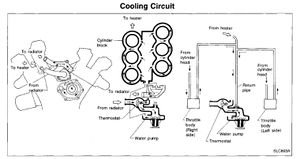Cooling System
The Cooling System in the Z32 is a collection of components assembled in such a way that they provide cooling to the engine, and provide heat for the cabin heater.
Contents
Components
The cooling system is made up of the following main components:
This system provides coolant to the following components:
- Engine Block & Heads
- Turbochargers (on equipped models)
- Throttle Bodies (heated)
- Heater Core (heated)
Coolant Circuit
The factory service manual does quite a good job explaining the cooling circuit in the VG30DE(TT). This is illustrated in the diagrams below.

In general, the cooling circuit has two paths. The first path (Thermostat Closed) is taken until the engine reaches near operating temp, at which point the thermostat opens and the coolant is circulated through the radiator before returning to the engine.
| Thermostat Closed |
Thermostat Open |
|---|---|
| Thermostat Housing ↓ Water Pump ↓ Engine Block ↓ Cylinder Heads ↓ IACV Device & Heater Core* ↓ Throttle Bodies ↓ [Turbochargers] ↓ Thermostat Housing & Water Outlet ↓ Thermostat Housing |
Thermostat Housing ↓ Water Pump ↓ Engine Block ↓ Cylinder Heads ↓ IACV Device & Heater Core* ↓ Throttle Bodies ↓ [Turbochargers] ↓ Thermostat Housing & Water Outlet ↓ Water Outlet ↓ Radiator ↓ Thermostat ↓ Thermostat Housing |
- *Heater Core outputs directly to Thermostat Housing
- **Throttle body coolant lines are commonly bypassed.
Operating Temperature
Standard operating temperature for the Z32 is around 185°F. Specifically, the ECU considers itself "warmed up" at 176°F. The stock thermostat begins to open at about 174°F and opens fully (about 10mm) at 194°F. Aftermarket thermostats (NISMO, Billion) are available that open at a lower temperature, though the merits of this lower opening point are a point of debate among Z32 enthusiasts. Some argue that lowering the operating temperature brings the engine out of if its most efficient temperature range and can increase wear, or prevent the ECU from entering its "warm" map. Others say the lower opening temperature only indicates when the thermostat begins to open, and that it behaves mostly the same as a stock thermostat except that it opens further.
Overheating
Overheating is an extremely dangerous condition in which the heat produced by the engine exceeds the amount of heat the cooling system can absorb. This is almost always caused by a failure in the cooling system on some level, or extreme engine load which simply produces more heat than the cooling system can handle.
The Z32's ECU considers the engine overheating at a temperature above 221°F. At this point, the temperature gauge begins to rise above the half-way point. The Z32 is designed to allow a bit of overheating without causing any long-term damaged, but in general, if you see the needle rise above the half-way point, something is wrong and you should pull over and shut down the engine as quickly as safety allows.
Because overheating is usually caused by a failure in the cooling system, the behavior in which the engine overheats can be the strongest clue as to what's wrong.
| Symptom |
Possible Causes |
|---|---|
| Overheating only at idle |
|
| Overheating while at speed |
|
| Overheating with A/C on |
|
| Consistent overheating, regardless of condition. |
|
| Overheating coupled by low coolant level after extended periods of driving. |
|
| Overheating coupled with sweet-smelling white smoke from exhaust |
|
| Overheating coupled by steam from engine bay and/or visible liquid dripping. |
|
Upgrades
In order to cope with extreme temperatures or driving conditions, there are a few common upgrades performed on the cooling system.
- Upgraded radiator. The stock radiator is adequate for ordinary driving and the cooling system can handle ordinary driving in basically any environment. However, to those living in extremely hot climates or who frequently track their Zs, an upgraded radiator is a common upgrade.
- Companies include Mishimoto, Koyo, SPL, and NISMO (stock equipment on Euro-spec Zs)
- Lower-temp Thermostat. The stock thermostat opens at about 174°F, which is close to the ideal operating temperature of the Z. Some opt to install a thermostat which opens at a lower temperature, reducing the temperature at which the engine operates. See the Operating Temperature section above for more information about this.
- High Pressure Radiator cap. The stock thermostat is designed to relieve pressure between 16psi and 18psi, allowing coolant to bleed into the overflow tank. However, most long-time enthusiasts recommend against aftermarket radiator caps, as they tend to increase the pressure beyond a safe point and cause failure in any of the many coolant lines around the VG30. When the system is operating normally, the stock radiator cap should be totally sufficient, even in extreme driving conditions.
Maintenance
The cooling system requires regular maintenance to ensure it's effectiveness and the longevity of its components. Nissan recommends replacing the engine coolant at 60,000 miles or 48 months, along with the thermostat, water pump, and various other components related to the timing belt system. After the first 60,000 miles, Nissan also recommends replacing the coolant every 30,000 miles or 24 months (whichever comes first).
The recommended anti-freeze to water mixture ratio is dependent on the ambient air temperature.
| Lowest Ambient Temperature |
Anti-Freeze : Water Mixture |
|---|---|
| 5°F (-15°C) |
30% Antifreeze/70% Water |
| -30°F (-35°C) |
50% Antifreeze/50% Water |
Running straight water is never recommended, as anti-freeze/coolant contains lubricant that is vital to the operation of the water pump.
Note: If not using premixed anti-freeze, it is highly recommended to mix anti-freeze/coolant with distilled water. Tap or drinking water contains minerals and particulates that can and will erode the water pump and other cooling system components. Use only glycol-based (green) coolant.
If you find that your Z32s cooling system has become excessively dirty or corroded (our iron blocks love to rust), a coolant flush can be performed.